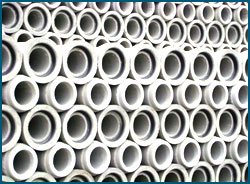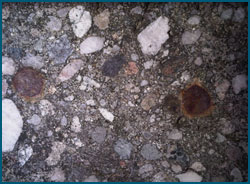Pipe Manufacturing: Vertical Casting v/s Spinning Process
 The traditional method used to manufacture concrete pipes in India is the horizontal, wet cast, spinning method. Here, cement, sand, gravel, aggregate and other admixture are accumulated in small manual mixers, using approximate measurements (manually). The mix is poured into a mould, which is spun using a motor to generate centrifugal force which binds the concrete. Each pipe takes 24 hours before it can be de-moulded. The traditional method used to manufacture concrete pipes in India is the horizontal, wet cast, spinning method. Here, cement, sand, gravel, aggregate and other admixture are accumulated in small manual mixers, using approximate measurements (manually). The mix is poured into a mould, which is spun using a motor to generate centrifugal force which binds the concrete. Each pipe takes 24 hours before it can be de-moulded.
In vertical casting, the cage is placed over a base pallet, which is attached to the outer mould and lifted by the crane. The crane carries the mould into the pit, around the inner core. The concrete is fed into a pit in the ground that is pre-fit with a mechanical vibrator, between the inner core and the outer mould, thus in the shape of the pipe. In the case of a manhole, there are sockets left open for pipes to later be fitted into. The concrete is vibrated in the machine and pressed down by a hydraulic pressing head to give the concrete its shape (by removing air bubbles and adding pressure). The pipe/manhole is then removed from the pit using a crane and put into a curing area. Depending on size, pipes are in the machine for 5-10 minutes.
 As vibration is used in this process, the concrete develops greater strength. Mainly, this is because in the spinning method, the centrifugal force causes the small and large aggregates to separate. There is uniform aggregate distribution along the horizontal span of the pipe in the vertical cast process, leading to higher pipe strength. As vibration is used in this process, the concrete develops greater strength. Mainly, this is because in the spinning method, the centrifugal force causes the small and large aggregates to separate. There is uniform aggregate distribution along the horizontal span of the pipe in the vertical cast process, leading to higher pipe strength.
Secondly, the vertical cast process is dry-cast, using 50% less water than the spinning process. This allows faster curing, resulting in greater output.
Thirdly, the vertical cast machine used by RBBR Infrastructure is fully automatic. Concrete mixes are completely consistent for every cubic meter produced, resulting in the exact same pipe quality throughout. |


